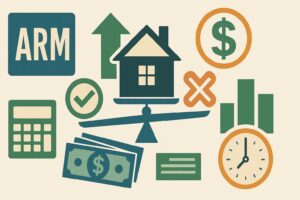Reading time: 4 minutes
Published: August 17, 2025
Modified: August 23, 2025
Adjustable-rate mortgages (ARMs) can seem confusing at first, but knowing how to decide if an ARM is right for you is key to making a smart home loan choice. Unlike a traditional fixed-rate mortgage, where your interest rate stays the same for the life of the loan, an ARM starts with a lower fixed rate for a set number of years, then adjusts periodically.
This flexibility can save money in the short term but comes with risks later on. Let’s explore how ARMs work, their benefits, and the factors you should understand before making your decision.

Key Takeaways
- An adjustable-rate mortgage (ARM) features a variable interest rate that changes after the initial fixed period.
- ARMs usually start with a lower interest rate compared to fixed-rate mortgages.
- After the fixed period, payments are recalculated (re-amortized) based on the remaining balance, the new rate, and the remaining term.
- Rate caps limit how much your rate can rise per year and over the life of the loan.
- Borrowers who plan to move or refinance within a few years may benefit from an ARM.
How Does an ARM Work?
An ARM typically begins with a fixed interest rate for a set period, such as 5, 7, or 10 years. After that, the rate adjusts annually or semiannually based on a market index plus a fixed margin set by the lender. Common indexes include SOFR (Secured Overnight Financing Rate) and certain U.S. Treasury yields; your loan disclosures will name the specific index and margin used to calculate adjustments.
What Happens After the Fixed Period Ends?
Once the fixed period ends, your loan balance is re-amortized over the remaining term. That means the lender recalculates your monthly payment based on:
- Your remaining loan balance
- The new interest rate
- The number of years left on the mortgage
Example: Suppose you take out a $300,000 30-year ARM at 5% with a 5-year fixed period. For the first five years, your payments are calculated as if you had a 30-year fixed loan at 5%. By the end of year five, you might owe about $275,000. When year six begins, your loan is recalculated over the remaining 25 years. If your new rate adjusts to 7%, your monthly payment jumps as if you started a brand-new 25-year loan at 7%. If rates fall instead, your payment could decrease.
Want to see how different rates affect your monthly payments? Try our Loan Amortization Calculator to run your own scenarios.
Understanding Rate Caps
To limit sudden payment shocks, ARMs include caps that restrict how much your rate can change:
- Periodic (annual) cap: The maximum amount your rate can increase at each adjustment, often 2%.
- Lifetime cap: The maximum total increase allowed over the life of the loan, often 5–6% above the initial rate.
Caps are often written in shorthand, such as “2-2-5.” This means the rate can rise a maximum of 2% at the first adjustment, 2% at each annual adjustment thereafter, and no more than 5% over the life of the loan.
Example: If your initial rate is 5% with a 2% annual cap and 5% lifetime cap, your rate could rise to 7% after the first adjustment, but it could never exceed 10% overall, no matter how high market rates go.
Why Choose an ARM?
Many borrowers choose ARMs because of the lower initial payments. This can free up cash flow for other priorities in the early years. An ARM may be a good fit if you:
- Plan to move or refinance before the fixed period ends
- Expect your income to rise in the future
- Believe interest rates will remain stable or decline
Risks of ARMs
While ARMs start with lower rates, they also carry uncertainty. If rates climb, your payments could rise sharply, straining your budget. Even with caps, a few years of rate increases can make an ARM more expensive than a fixed-rate mortgage. Borrowers who value predictability or plan to stay in their home long-term often prefer fixed-rate loans.
Is an ARM Right for You?
The decision comes down to your goals and risk tolerance. If you’re comfortable with potential payment increases and have a clear exit strategy, like selling or refinancing, an ARM can be a smart choice. If you prefer long-term stability, a fixed-rate mortgage may give you more peace of mind.
Conclusion
Adjustable-rate mortgages offer a mix of lower upfront costs and future uncertainty. By understanding how amortization works, how rate caps protect you, and how payment changes might affect your budget, you can decide if an ARM aligns with your financial plans. As with any major financial decision, the key is to balance the potential savings with the risks and choose the loan structure that fits your long-term goals.
For additional reading, see Bankrate’s ARM vs. Fixed-Rate Mortgage guide ↗.